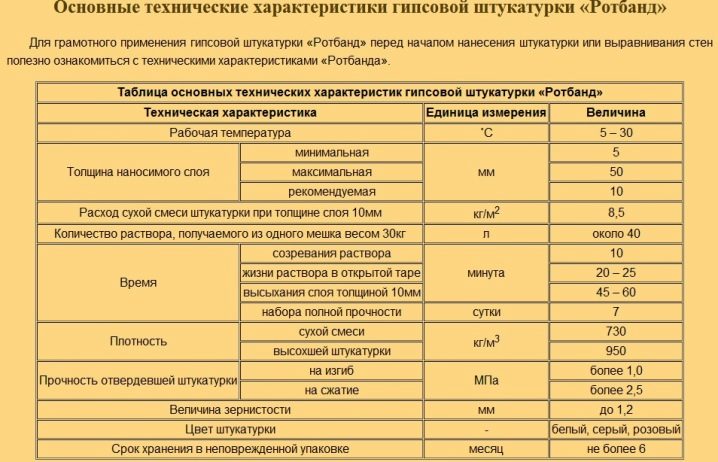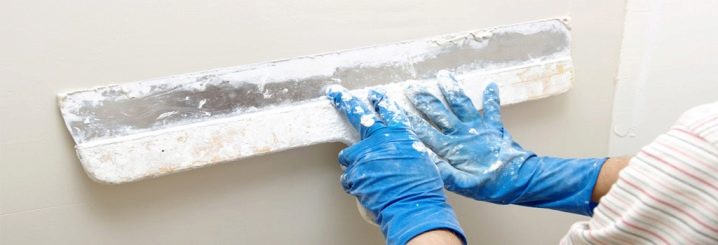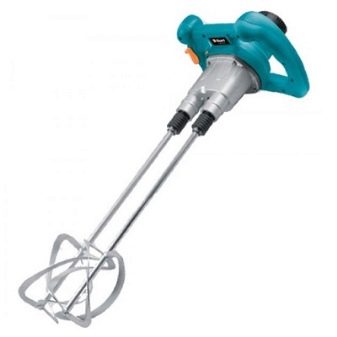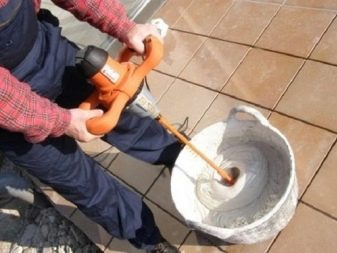Plaster Rotband: instructions for use

Building materials of the German manufacturer Knauf have been leading in the sales list for more than a year on the Russian market. One of the most sought-after products is Rotband plaster. Instructions for the use of this material is simple and understandable even for a beginner, the technical characteristics of the plaster are high, and the German quality speaks for itself.
Special features
Knauf “Rotband” has earned the recognition of repair specialists and newbies for many reasons. It is noteworthy that the approach to the selection of raw materials for the manufacture of their products from the founders of the company is purely professional. The Knauf brothers are mountain builders by profession.For many years they sought to pick up such material that would be of high quality, economical and easy to work, and stopped on a cast.
A large amount of this mineral in the composition of the plaster provides all its unique properties and advantages:
- The plaster mix “Rotband” is distinguished by a carefully thought out composition. Its basis is a fine powder from career gypsum. It adds components of natural origin, which increase elasticity, the ability of the solution to retain moisture longer, adhesion to the working surface and strength.
- Moisture-retaining components in the composition protect the layer from cracking after application to the wall or ceiling.
- The material is multifunctional in repair. It copes with many tasks and allows you to close up deep goals, align walls with curvature differences up to 5 cm in one step, prevent heat loss, improve noise insulation in the room, prepare the surface of walls and ceiling for decorative finishing, perform decorative decoration itself and even restoration work.
- The instructions for use are accurate and understandable, so Knauf "Rotband" is suitable for professional use and making repairs on your own.Numerous reviews confirm that repairing with materials from the “Rotband” line is not at all difficult.
- Plaster mix universal. Best of all, it lies on relatively flat concrete, cement or cement-plastered surfaces, but is also suitable for working on other bases. In particular, brick walls and porous materials, which are characterized by high moisture absorption, drywall, DSP and OSB slabs. It copes well with the alignment and decoration of walls in old premises and on the grounds that have repeatedly experienced redecoration.
- Thanks to the work of the production concern at the international level, the products comply with European quality standards recognized in any country and are adapted to the climatic conditions of different countries, including the difficult Russian climate.
- Plaster coating is durable and wear-resistant in dry and wet areas. It is suitable for decoration of bathrooms, bathrooms and kitchens, if special compositions are used to protect the plaster.
- The mixture is capable of "not clashing" in tandem with finishing materials from other manufacturers and is most effectively combined with the products.inside your own line.
- The liquid solution is very plastic, but does not flow over the surface. It is convenient to use when finishing problem areas.
- No need to use a putty after applying Rotband plaster.
- Gypsum is very economical when finishing walls and ceilings, it is not required as much as cement-sand mixtures. This saves both finances and time for repairs.
- The thickness of one layer is plus or minus 50 millimeters. This is usually enough to level the wall in one go.
- Frozen plaster coating is resistant to fire.
- Gypsum plaster allows the wall to "breathe", which means that no condensation will form under the finishing material.
- Gypsum is a mineral substance of natural origin. It does not cause allergic reactions and does not emit toxins.
The drawbacks should also be noted. As noted by many experts, the solution may shrink slightly. This is important to consider when calculating the consumption of a substance and diluting it with water.
There may also be trouble when trying to apply a second five-centimeter layer to the first one without a primer composition between them. Strength in this case is not up to par.
For beginners, material consumption can greatly exceed the figures specified by the manufacturer. The mixture hardens on contact with air in less than an hour. Need to work very quickly.
In comparison with similar products from other manufacturers, the price range of Knauf “Rotband” plaster is more premium-class than economical.
Specifications
They deserve special attention because they determine the quality and durability of the material.
In addition to the already mentioned composition, such characteristics as packaging, storage, layer thickness, strength and density, color and fraction size, temporal characteristics are taken into account.
The release form of the “Rotband” plaster is packed bags of 5, 10, 25 and 30 kg. Five-kilogram packages are made of polyethylene and paper, heavier - only paper. Such packaging not only helps to keep the dry gypsum mix usable, but also carries information useful to the buyer. On all packages there is a company distinctive sign - a stamp “German standard. Proven quality. In addition, the marking with the time of packing the goods in the format: year, month, hour, second.On the outer layer of the package there is an embossing - strip.
These simple signs help to distinguish branded products from poor-quality fakes.
Paper or plastic containers are stored in a dry and ventilated place at a temperature not lower than 0 degrees and not higher than 25. It is advisable to prevent the mixture from heating up and exposure to sunlight.
Outside on the package there is an information table in which the main characteristics are indicated. According to these data, the size of the fraction can not exceed 1.2 mm. This indicator is important for the "fluidity" of the solution. The smaller the fraction, the stronger it “crawls” along the wall. The larger, the better it keeps on the wall and the higher the adhesion with the treated surface.
The color is not specified, but the manufacturer claims that it does not affect the performance characteristics of the plaster. The hue of gypsum does not depend on the addition of the dye, but on the place where it is mined. The finished solution can be painted in white, gray or pinkish color. White plaster enters the market from German and Krasnodar plants, gray - from Krasnogorsk, pinkish - from Kolpino.
The recommended layer thickness varies with ceiling trim and wall treatment. For horizontal surfaces, the minimum is 5 millimeters, and the maximum is 15.For vertical - from 5 to 50.
Temporary indicators are superimposed on each process separately. So, the solution "matures" after adding water in 3-7 minutes, remains liquid and suitable for working 25-35 minutes, a thin layer dries in 3-5 hours, and the thickest one - only in 7 days.
Indicators of density and strength to verify independently is almost impossible.
They regulate the maximum load on the plaster layer, and the manufacturer sets the following figures for the “Rotband” line:
- Density - 950 kg / cubic meter;
- Compressive strength - not less than 2.5 MPa;
- Bending strength - not less than one.
The last but most important characteristic is the mixture consumption per square meter. It deserves detailed consideration.
Consumption per 1 m2
The condition of the working surfaces is different, and the consumption of material is averaged - for a layer of 1 cm. The role and professionalism of the person performing the repairs plays a role. Painters-specialists as accurately as possible can determine the required thickness of the layer, but for lovers it often seems that more means better. Where it was possible to do with two centimeters of thickness, they impose a maximum, as a result, the flow rate greatly increases.
With the fact that Knauf "Rotband" products are not the most budgetary option, this waste of money can afford.
To avoid unnecessary time and financial costs, you need to correctly calculate the gypsum mixture per square meter.
This is done manually step by step:
- "Stabbing" the walls. A perfectly flat surface is an exception rather than the rule, therefore it is necessary to compare height differences at least at three points. For this, the length of the base of the wall is divided into three equal lengths, in the middle of each segment a nail is driven in 20 cm from the ceiling, a cord with a weight is tied to the nail. Below, at the point where the load stops, they hammer in another nail and fix the tip of the cord. The same cord can be stretched along a horizontal line. This method allows you to accurately determine the differences in curvature of the walls.
- Calculation of arithmetic average. This indicator will be equal to the required thickness of the plaster layer in order to make the wall as flat as possible. For example, if the length of a wall is 9 meters, three sheds were placed on it, and the deviations turned out to be 1, 2 and 3 centimeters, they need to be folded and divided by the number of sheds.The total amount of curvature is 6 centimeters, and the leveling layer should be 2 cm.
- Calculation of material per 1 square meter. The package contains the minimum layer thickness for a square meter. From these data it is easy to get both the maximum and average index. For example, at a layer thickness of 2 cm, the data from the information table should be multiplied by 2. For “Rotband” plaster, the consumption is 1 square meter. m at 1 cm is equal to 8.5 kg. It turns out, for 2 you will need 17 kg per meter.
- Calculation of the material on the entire area. 17 kg (another resulting number) must be multiplied by the wall area. For each surface, the calculation is carried out separately.
- Calculate the number of packages of plaster. The total weight of the plaster must be divided into 5, 10, 25 or 30 (kg in 1 package). The larger the volume, the cheaper the price per kg, so it is better to focus on larger packaging.
- Stock plaster. Even manual calculation does not give 100% accurate results. The number of bags of plaster needed to repair the room is always rounded up. At 10.5 - up to 11, at 12.5 - up to 13. If the number turned out to be even, an additional bag is purchased in the amount of 5-15% of the total mass.
For ceilings, calculations are performed in the same way, but taking into account the fact that the maximum permissible layer thickness is only 15 mm.
Drying time
For the application of primer and decorative finish, following plastering, you need a completely dry and smooth surface.
The thickest layer in 5 cm dries for 7 full days. Based on this, you can make an approximate calculation of the time for drying a layer of 1 cm - from 24 to 34 hours. The exact figure depends on the layer thickness (1 cm will dry faster than 3) and the type of surface. On porous and well-absorbing walls (blocks of aerated concrete, brick) plaster quickly loses moisture and dries faster, on materials of average absorption (like drywall) and average indicators, and on dense concrete foundations the maximum waiting time.
How to apply?
The technology of applying Rotband plaster is available to anyone. It is carried out in stages - from preparatory work to treatment with protective agents.
Preparatory work
Painting works without prior preparation - money and time to the wind. The premises to be repaired must be cleared of debris, if there is one, dry-cleaned (to remove building dust) and damp. Clean walls or ceilings must be primed with a suitable type of surface compound in two layers after a gap of several hours.
The best option - primer Knauf.
It is recommended to protect the floor covering with a thick plastic film.by fixing it with masking tape. This will eliminate the need to remove from the floor white plaster streaks and frozen drops of the solution.
If preparation is not made, problems such as cracking of the plaster, peeling, and the appearance of irregularities are possible.
Preparation of tools
For painting, you will need several containers under water (pour into the plaster mix, wash the tools) and mortar, stepladder, paint patch to partially batch the solution for the treatment of deep crevices, trowel, trowels, trowel, spatulas and a special tool called the rule.
To mix the solution you need a construction mixer. A drill with a mixing attachment is also suitable.
Also worth stocking up with work clothes, comfortable shoes, gloves. When plastering the ceiling with a respirator, goggles and a hat or scarf to protect the hair.
Mixing solution
When the second coat of primer dries (after about 24 hours), it’s time to proceed directly to the finish. Old brickwork, porous materials and wood with good absorbency can be coated with a primer in three layers, but thin.
Mixing solution is made in plastic containers. Use pure water at room temperature and a mixer or drill. It is necessary to strictly follow the manufacturer's recommendations on the temperature and amount of fluid and thoroughly mix the gypsum mass until homogeneous.
Infused solution to 10 minutes, then proceed to the application. To seal deep gaps and form pyramid beacons on the wall, it is prepared in small quantities separately, so that the rest of the mass does not solidify.
There are several ways to apply “Rotband” plaster: in 1 step, in 3 steps and at the beacons.
For application in one step, the wall must be sufficiently smooth and not problematic. In this case, the finished solution is gathered on the trowel and applied to the wall from bottom to top, departing from it a distance equal to the thickness of the layer. Thus the whole area is covered.
The layered version is designed for difficult surfaces that need to be further reinforced.
In total three layers are applied:
- "Spray" - a liquid solution of minimum thickness;
- "Soil" - the main layer, the thickness of which is 3-4 cm. If necessary, a paint net for reinforcement is "embedded" in it;
- "Cover" - a thin finishing layer, leveling the surface of the wall and the grid.
Further, several options are possible. If the wall is already flat, then apply a plaster to the finish before decorating; if there are still defects, prime the coating and re-apply the plaster again with one layer of the desired thickness.
Grout
It is started when the plaster has already “grabbed” but has not hardened completely. Paint roller put to the wall and start in circular motions to process from left to right.
The pressure should be small, so as not to damage the fresh plaster.
Tips and tricks
Do the job well with Rotband plaster, professional advice for beginners will help:
- always worth buying material with a margin;
- do not mix a lot of solution at once
- add water to the dry mixture, and not vice versa, and do not pour all recommended volume at once;
- work in a dry room, observing temperature from +5 to +25;
- consider in advance whether the plaster will perform a decorative function and apply the relief already in the process of plastering;
- use two layers of high-quality primer;
- before applying the plaster, remove all metallic elements from the wall or paint over 2 layers of white enamel;
- Do not try to speed up the drying process with heat fans and heaters - moisture will evaporate too quickly and the surface may crack.
You can find out how to level the ceiling and walls with your own hands from the video below.





































































